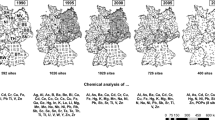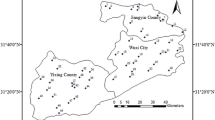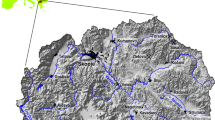Abstract
The contents of 36 elements were determined in Pleurozium schreberimoss collected along 12 linear transects at 56 sampling points running radially up to a distance of 14 km from the secondary smelter ground at Příbram in the Czech Republic. Moss monitoring techniques enabled an assessment of the distribution of relative and, for many elements, the absolute atmospheric deposition rates that have been found for many elements in the details of land cadastres and allotments over an area of 700 km2. In addition to the hot spots for accumulation of smelter elements centred on the smelter ground, other unexpected hot spots caused by the operation of previously underplayed pollution sources are revealed in fine-scale contour maps. The decrease in element content in moss with distance from the centres of the main hot spots were described remarkably well by regression equations. The results of PCA indicated that the distribution of these elements in moss in the area is substantially controlled by 4 factors. The smelter was found to be the crucial current emitter of Ag, As, Cd, Cu, (Hg), In, Pb, Sb and Zn. Gravel production from stone material from abandoned uranium pits has been a major source of Al, As, Be, Ce, Cr, Fe, Ga, La, Li, Nd, Pr, Sc, Th, U, V and Y pollution, and a piston-ring works has been contaminating the area heavily with Mo. The fourth factor controlling the distribution of Cs, Rb and Tl in moss may be the combined operation of non-industrial anthropogenic and geogenic factors. The content of some elements in the moss correlated with selected geomorphological characteristics. The estimated enormous deposition loads of many potentially hazardous elements from the smelter and the stone mill from the former uranium pit in the town should be taken into account as a hazard to the inhabitants. The plan to continue utilising the 20 remaining heaps from the abandoned uranium pits for gravel production should be abandoned because it would lead to major further contamination of the area. Fine-scale moss monitoring techniques have proved to be a powerful tool for determining the deposition rates of many elements around diverse point sources of pollution in the landscape.
Similar content being viewed by others
References
Bambas, J.: 1990, Březohorský rudní revír (Ore mines at Příbram – Březové Hory), Committee of the Mining Symposium Příbram, Kamenná, pp. 198 (in Czech).
Bargagli, R., Brown, D. H. and Nelli, L.: 1995, 'Metal biomonitoring with mosses: Procedures for correcting for soil contamination', Environ. Pollut. 89, 169–175.
Bartók, K.: 1988, 'Heavy metal distribution in several lichen species in a polluted area', Rev. Roumaine de Biol. 33, 127–134.
Berg, T. and Steinnes, E.: 1998, 'Use of mosses (Hylocomium splendens and Pleurozium schreberi) as biomonitors of heavy metal deposition: From relative to absolute deposition values', Environ. Pollut. 98, 61–71.
Brumelis, G., Brown, D. H., Nikodemus, O. and Tjarve, D.: 1999, 'The monitoring and risk assessment of Zn deposition around a metal smelter in Latvia', Environ. Monit. Asses. 55, 201–212.
Bunzl, K., Albers, B. P., Shimmack, W., Rissanen, K., Suomela, M., Puhakainen, M., Rahola, T. and Steinnes, E.: 1999, 'Soil to plant uptake of fallout Cs-137 by plants from boreal areas polluted by industrial emissions from smelters', Sci. Total Environ. 234, 213–221.
Cikrt, M., Smerhovsky, Z., Blaha, K., Nerudova, J., Sediva, V., Fornuskova, H., Knotkova, J., Roth, Z., Kodl, M. and Fitzgerald, E.: 1997, 'Biological monitoring of child lead exposure in the Czech Republic', Environ. Health Perspect. 105, 406–411.
ČGÚ: 1986–1998, 'Geologická mapa odkrytá', (A geological map of the Czech Republic 1:50 000, Sheets 12–34, 12–43, 22–12, 22–21), Czech Geol. Survey, Prague (in Czech).
Fabiszewski, J., Brej, T. and Bielecki, K.: 1987, 'Plant reactions as indicators of air pollution in the vicinity of a copper smelter', Acta Soc. Bot. Polon. 56, 353–363.
Fernandez, J. A., Aboal, J. R. and Carballeira, A.: 2000, 'Use of native and transplanted mosses as complementary techniques for biomonitoring mercury around an industrial facility', Sci. Total Environ. 256, 151–161.
Frontasyeva, M. V. and Steinnes, E.: 1995, 'Epithermal neutron-activation analysis of mosses used to monitor heavy-metal deposition around an iron smelter complex', Analyst 120, 1437–1440.
Genoni, P., Parco, V. and Santagostino, A.: 2000, 'Metal biomonitoring with mosses in the surroundings of an oil-fired plant in Italy', Chemosphere 41, 729–733.
Goodarzi, F., Sanei, H. and Duncan, W. F., 2001, 'Monitoring the distribution and deposition of trace elements associated with a zinc-lead smelter in the Trail area, British Columbia, Canada', J. Environ. Monit. 3, 515–525.
Helmisaari, H. S., Derome, V. J., Fritze, H., Nieminen, T., Palmgren, K., Salemaa, M. and Vanha-Majamaa, I.: 1995, 'Copper in Scots pine forests around a heavy-metal smelter in south-western Finland', Water Air, and Soil Pollut. 85, 1727–1732.
Holub, M.: 1995, 'Sledování distribuce tyzkých kovu na okrese Príbram', (Investigation of distribution of heavy metals in the district of Příbram), Report of the Res. Project GA/52/93, ELEMKOM, Malý Beranov, pp. 25 (in Czech).
Jongman, R. H. G., Ter Braak, C. J. F. and Van Tongeren, O. F. R. (eds.): 1996, Data Analysis in Community and Landscape Ecology, new ed., reprint, Cambridge University Press, Cambridge, New York, Melbourne, pp. 299.
Jordao, C. P., Pereira, J. L., Jham, G. N. and Bellato, C. R.: 1999, 'Distribution of heavy metals in environmental samples near smelters and mining areas in Brazil', Environ. Technol. 20, 489–498.
Jovanovic, S., Carrot, F., Deschamps, C., Deschamps, N. and Vukotic, P.: 1995, 'A study of the airpollution in the surroundings of an aluminium smelter, using epiphytic and lithophytic lichens', J. Trace Microprobe Techniques 13, 463–471.
Kansanen, P. H. and Venetvaara, J.: 1991, 'Biological collectors of airborne heavy metals near ferrochrome and steel works', Water, Air, and Soil Pollut. 60, 337–360.
Kalac, P., Burda, J. and Staskova, I.: 1991, 'Concentrations of lead, cadmium, mercury and copper in mushrooms in the vicinity of a lead smelter', Sci. Total Environ. 105, 109–119.
Keckler, D.: 1997, Surfer for Windows, Version 6. User's Guide, Golden Softvare, Inc., Golden, CO.
Ketterer, H. E., Lowry, J. H., Simon Jr., J., Humphries, K. and Novotniak, M. P.: 2001, 'Lead isotopic and chalcophile element compositions in the environment near a zinc smelting secondary zinc recovery facility, Palmerton, Pennsylvania, U.S.A.',Appl. Geochem. 16, 207–229.
Komínek, J.: 1995, 'Přehled distribuce hydrotermálních žil a uranového zrudnění v příbramském uranovém ložisku', (Overview of hydrothermal lodes and uranium ore distribution in Příbram), Uhlí, Rudy Geolog. Pr°uzk. 4(1), 6–11 (in Czech).
Mankovska, B. and Steinnes, E.: 1997, 'Multivariate analysis of element data from needles of Pinus sylvestris L. and Picea abies (L.) Karst. Samples used to monitor atmospheric deposition in area of aluminium plant' Ekológia, Bratislava 16, 213–223.
Mukherjee, A. B. and Nuorteva, P.: 1994, 'Toxic metals in forest biota around the steel works of Rautaruukki Oy, Raahe, Finland', Sci. Total Environ. 151, 191–204.
Nieboer, E., Ahmed, H. M., Puckett, K. J. and Richardson, D. H. S.: 1972, 'Heavy metal content of lichen in relation to distance from a nickel smelter in Sudbury, Ontario', Lichenologist 5, 292–304.
Onianwa, P. C.: 2001, 'Monitoring atmospheric metal pollution. A review of the use of mosses as indicators', Environ. Monit. Asses. 71, 13–50.
Poikolainen, J.: 1997, 'Sulphur and heavy metal concentrations in Scots pine bark in northern Finland and the Kola Peninsula', Water, Air, and Soil Pollut. 93, 395–408.
Preiningerová, B.: 1982, 'Spad živin a škodlivin dešt'ovými srážkami', (Rainfall pollution by nutrients and harmful substances), Rostlinná Výroba 28, 1095–1108 (in Czech).
Reimann, C.,De Caritat, P., Hallekarer, J. H., Finne, T. E., Boyd, R., Jæger, Ø., Volden, T., Kashukuna G., Bogatyrev I., Chekushin, V., Pavlov, V., Äyräs. M., Räisänen, M. L. and Niskavaara H.: 1997, 'Regional atmospheric deposition patterns of Ag, As, Bi, Cd, Hg,Mo, Sb and Tl in a 188 000 km2 area in the European arctic as displayed by terrestrial moss samples – Long-range atmospheric transport vs. local impact', Atmosph. Environ. 31, 3887–3901.
Rieuwerts, J. S. and Farago, M.: 1996a, 'Heavy metal pollution in the vicinity of a secondary lead smelter in the Czech Republic', Appl. Geochem. 11, 17–23.
Rieuwerts, J. S. and Farago, M. E.: 1996b, 'Mercury concentrations in a historic lead mining and smelting town in the Czech Republic: A pilot study', Sci. Total Environ. 188, 167–171.
Rieuwerts, J.S., Farago, M., Cikrt, M. and Bencko, V.: 1999, 'Heavy metal concentrations in and around households near a secondary lead smelter', Environ. Monit. Asses. 58, 317–335.
Rieuwerts, J. S., Farago, M. E., Cikrt, M. and Bencko, V.: 2000, 'Differences in lead bioavailability between a smelting and a mining area', Water, Air, and Soil Pollut. 122, 203–229.
Ross, H. B.: 1990, 'On the use of mosses (Hylocomium splendens and Pleurozium schreberi) for estimating atmospheric trace metal deposition', Water, Air, and Soil Pollut. 50, 63–76.
Rühling, Å.: 1994a, Monitoring of Atmospheric Heavy-metal Deposition in Europe using Bryophytes and Humus Samples as Indicators. Proposal for an International Programme 1995, Environ. Monit. Data Group of Nordic Countries, Univ. Lund, pp. 15.
Rühling, Å. (ed.): 1994b, 'Atmospheric heavy metal deposition in Europe, estimations based on moss analysis', Nord 9, 1–53.
Rühling, Å. and Steinnes, E. (eds.): 1998, 'Atmospheric heavy metal deposition in Europe 1995– 1996', Nord 15, 1–66.
Schaug, J., Rambæk, J. P., Steinnes, E. and Henry, R. C.: 1990, 'Multivariate analysis of trace element data from moss samples used to monitor atmospheric deposition', Atmosph. Environ. 24A, 2625–2631.
Steinnes, E.: 1995, 'A critical evaluation of the use of naturally growing moss to monitor the deposition of atmospheric metals', Sci. Total Environ. 160/161, 243–249.
Steinnes, E., Rambæk, J. P. and Hanssen, J. E.: 1992, 'Large scale multi-element survey of atmospheric deposition using naturally growing moss as biomonitor', Chemosphere 25, 735–752.
Suchara I. and Sucharová J.: 2004, 'Distribution of 36 element deposition rates in a historic mining and smelting area as determined through fine-scale biomonitoring techniques. Part II: Relative long-term accumulated atmospheric deposition levels', Water, Air, and Soil Pollut. 153, 229–252.
Sucharová, J. and Suchara, I.: 1999, 'Multielementární analýzy mechu a humusu v okolí Přríbrami' (Multielemental analyses of moss and forest floor humus around the town of Pžíbram), Final Report, Project VaV/610/3/97, Research Institute of Ornamental Gardening, Průhonice, pp. 104 (in Czech). 228 J.
Thöni, L.: 1996, Vergleich von Elementkonzentrationen in drei Biomonitoringmoosen untereinander und mit Depositionsfrachten im Bulksammler nach Bergerhoff,Bundesamt für Umwelt, Wald und Landschaft, Egg, pp. 89.
Tomasek, L. and Darby, S. C.: 1995, 'Recent results from the study of west Bohemian uranium miners exposed to radon and its progeny', Environ. Health Perspect. 103, 55–57.
Author information
Authors and Affiliations
Corresponding author
Rights and permissions
About this article
Cite this article
Sucharová, J., Suchara, I. Distribution of 36 Element Deposition Rates in a Historic Mining and Smelting Area as Determined through Fine-Scale Biomonitoring Techniques. Part I: Relative and Absolute Current Atmospheric Deposition Levels Detected by Moss Analyses. Water, Air, & Soil Pollution 153, 205–228 (2004). https://doi.org/10.1023/B:WATE.0000019944.33209.83
Issue Date:
DOI: https://doi.org/10.1023/B:WATE.0000019944.33209.83




